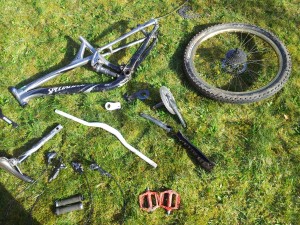- 6. Popular Mountain Bike Brands
- 7. The Best Mountain Bikes, by Category
- 8. Where to Buy a Mountain Bike
- 9. Used Mountain Bikes: Buying Second Hand
- 10. Mountain Bike Sizing
Chapter 5: Mountain Bike Parts Guide
The Parts of Mountain Bike & the Brands and Models to Buy
 Now we’re down the nuts and bolts. Literally. This is where we start to look at the mountain bike parts that separate an average bike from a good one. In our case, parts are usually called components, so you’ll normally hear people talking about mountain bike components rather than parts.
Now we’re down the nuts and bolts. Literally. This is where we start to look at the mountain bike parts that separate an average bike from a good one. In our case, parts are usually called components, so you’ll normally hear people talking about mountain bike components rather than parts.
So, why are we interested in the mountain bike parts? If you follow my advice in the earlier chapters, you wont buy a bad mountain bike after all. As long as you spend over £250 for a hardtail or £750 for full suspension, and you hit one of the decent brands, you’ll get something that’s easily good enough to get started on.
But, if you’re a bit higher up the biking tree, looking to get yourself a better bike, the components are the first thing you’ll look at. They’re the detail that show you the quality of the bike.
Makes, Models & Mystery: How to Read Model Names
This is where most people start to get a bit edgy. The range of makes, models and sub-types you’ll find in a bike shop is pretty ridiculous. And, to make things worse, normally they’re have pretty useless names such as…
Superbike X70, Superbike X90, Superbike Y90, Superbike Y110
What the heck do the numbers mean? Is higher better, or lower? What about the letters?
Sadly, the brands can’t seem to agree on a good answer to any of that. Some brands use words to signify levels of quality, and some use numbers. Of the ones that use numbers, some signify the best parts with a high number, and some use low numbers. It’s all pretty confusing, so it’s not wonder that so many people end up getting the wrong bike.
De-Mistifying the Naming Conventions
Here’s how it works, and this counts for both fully assembled bikes as well as for mountain bike parts.
Mountain Bike Brands
Every bike part has a brand – that’s the company that makes it. Think Ford, Volkswagen or Volvo for cars. This is your first indication as to quality. Some brands are known for more reliable parts, or sbikes that ride really well. The standard rule of life applies here – the better the brand, the more you’ll spend and the better your bike will be.
In mountain biking there aren’t really any flashy brands that cost and lot but don’t deliver quality. There’s a good range of top quality brands that are around the same price level, but you do get a few great brands that tend to offer a bit more value. There are two common reasons for this: either they’re a newer company, so haven’t build up their long term relationship yet, or they’re just a bit less fashionable, so can’t quite charge the premium prices. Either way, these tend to be great places to get quality, value bikes.
Mountain Bike Models
Next, every bike and part has a model. This is because each brand wants to make a range of kit for different uses. Again in terms of cars, think Polo, Passat or Golf, all models of Volkswagen.
Brands will often have a big range of models with two aspects to them.
First, they’ll have models that fit the different mountain bike types (check out chapter 2 for a recap). So they‘ll have bikes and parts for cross country riding, for all-mountain riding and for downhill biking use, among others.
Second, they’ll often have a few different levels within each type. So, they’ll have entry-level, average level and top-spec levels within that type at a minimum.
As an example, putting the two together, one brand might have an economy cross-country bike, a standard cross-country spec and top quality cross-country bike. And that would just be three models from a much larger range.
Naming Conventions
Helpful manufacturers will often give bikes a number ranking within their model names. Here’s an example from a good Mountain Bike Brand, Trek. Their All-Mountain Model is called the Remedy, and they have 3 specification levels on that model, called the 7, 8 and 9. Here, higher is better, so the Trek Remedy 9 is top-class All-Mountain beast that’ll set you back £3k+. At least they make it easy to tell though!
Other brands don’t make it quite so easy, so you just have to do a little research. For example, Specialized have three Rockhoppers (their mid-range trail-riding hardtail): the simply named Rockhopper, the higher level Rockhopper Comp and the top-level Rockhopper Pro. Easy once you’ve figured it out, but not entirely obvious to start with. If you want the shortcut though, just have a look at my brand guide just a few chapters on. Easy!
Ranking Mountain Bike Parts: What To Look For
Now that we know how it all works, we’d better figure out the details. What are we actually looking for?
The are certain components that are worth far more than others. So, a top quality frame, for example, is worth far more than a top-quality front-mech. We’ll look at each component in ranking order, so this is the order you want to follow when checking out a new bike. Within each component section I’ll take you through the standard types and model names. That’ll arm you with enough info to start ranking bikes, and make sure you’re getting the best bang for your buck.
Biking Frames
The Frame is the backbone of your bike. It’s what joins everything else together so it’s a pretty key part to get right. There are a ton of options here, but, to me, there are two main ways to go.
1. Get the best frame you can afford, and forget about the other bits. A good frame will last for years and, fitted right, it can make a huge difference to how much you enjoy riding your bike. Many of the components will wear out after a year anyway, two at the most, and with a good frame to build on, you can upgrade over time. This way your bike grows with you, it’s quality rising along with your skill.
An example of this is buying a bottom spec Specialised Rockhopper. The Rockhopper has a great frame, and the bottom level components will do you fine for the first year. In year two you upgrade to the next level, and keep following that path, ending up with a bike to rival a lot of the top models.
2. Get a basic, decent frame and blow-out on the components. There’s no question – bike parts can make a big difference to your enjoyment as well. There’s nothing like a cheap, worn rear mech for generating irrational anger. Gears skip, shins meet pedal with a sickening crunch and your bike is thrown off the switchback as you hop around cursing everything within sight.
Following this route gets you a great set of components straight away, and they’ll treat you well all year long. But, your bike will have a ceiling. At some point you’ll outgrow that bottom level frame and have to shell out a fair whack to get to the next level. You don’t even save much on components as mid and high level components don’t last too much longer than their value counterparts, as long as they’re from the good brands. They just perform so much better over the same time period.
The example here from the same brand is the Hardrock. This is Specialized’s entry level bike, but the top spec model comes with a great set of components for the price. You could happily ride the Hardrock for your first couple of years before upgrading to something a bit more refined.
For a full list of frame types, as well as recommendations on what to buy, check out the dedicated chapter on mountain biking brands.
Mountain Bike Gearing
Next in line is the gearing – this is what lets us fire down the hill at top speed, but still allows a slow enough ascent to prevent us coughing up a lung. During a day’s biking you’ll put a lot of force through your gears, and you’ll be mashing them up and down to handle the terrain on even the gentlest of trails.
Despite the torture you put them through, your gears need precision and reliability to provide smooth and snappy shifting. It’s these requirements that separate the low end components from the high end gearing parts.
First off we have the mechs, or the derailleurs. To be honest, I haven’t a clue why there are two names for the same part. Sounds French to me… Anyway, mechs and derailleurs are the same thing, and you have two on every mountain bike – a front and a rear. The front mech handles the big gears – it shifts the chain up and down the two or three chainrings that are attached to your pedal crank.
The rear mech, on the other hand, handles the little gears at the back – the ones that provide the fine adjustment.
The front mech is used the least and covers quite a big movement on each shift. This means it doesn’t need as much precision or reliability and so tends to be a fair bit cheaper.
The more important of the two is the rear mech – it makes short, precise shifts and it does it often. I’ve already mentioned the rage a badly performing rear mech can produce, and complete mech explosions aren’t that uncommon. Because of this, the rear mech is probably the second thing I normally look at to assess the quality of a mountain bike.
In parallel with the rear mech, we have the shifters. These are the devices mounted to your handlebars that you work with your fingers to shift the gears. Normally the rear mech and shifters will be of the same component level, and so of matching quality. Often, the front mech will be a level lower, to save a few pennies, but that’s not too important if so.
For full details on mountain bike gearing parts, have a look at the Mountain Bike Gears Chapter.
Mountain Bike Suspension
You wont find many people these days riding a mountain bike without any suspension. Those that do are usually fanatics who have built up some sort of torture device in the guise of a mountain bike. That can sometimes even extend to a lack of gears ridden by a lycra-clad muscular skeleton of a mountain biker. He’ll be found perversely riding a fixie up and down mountains that would defeat a normal man and his granny ring.
For us mere mortals suspension is both a comfort and a necessity. Necessary because it makes things so much more fun, and, once you know how to use it, even more fast.
Suspension is split into front (forks) and rear (shocks), and both come in a dizzying range of types, models and price levels. Suspension is split by a whole range of factors. Firstly, most setups are aimed squarely at one of the mountain biking types. You get heavy big-travel forks and shocks for downhill, and light, short travel ones for cross country. They’re also the bike parts which boast one of the biggest ranges in price. Top quality suspension will cost you. Not just a lot, but as much as an entire mid-range bike in some cases.
But, top quality suspension is fuuuuunnn. Nothing feels quite like a plush, top-end mountain bike when things get fast and rough. For the full low-down on suspenion, have a look at our Mountain Bike Suspension Chapter.
Mountain Bike Wheels
Wheels aren’t just for turning, they have a huge effect on your ride. Because of all sorts of complicated physics, losing a little weight on your wheels makes a big difference, much more so that losing the same weight on your frame, for example. Not only that, but stiffness and size can completely change the way your bike rides. Suffice to say, this is a pretty important component to look at.
Wheels are a little complicated, though, in that there are a LOT of choices. In your early days you can generally stick to whatever comes with your bike. Once your speed picks up and the drops get higher you’ll start to think about upgrading. When that times comes, have a look at our Mountain Bike Wheels chapter.
The Rest
I’ll never claim that the rest of the bike isn’t important, but if you find a bike with a decent set of the above components, then it’s unlikely that the manufacturer will have skimped on anything else.
Once you’re moving up the skill levels, though, you’ll want to put a bit more thought into your setup. Brakes are well worth looking at next, then chainsets, saddles, stem & bars, and more. For full info on each of these, check out the relevant chapters in this guide.
For now though, enjoy speccing out your new bike.
Put your questions in the comments below – I look forward to hearing from you!
Read More of the 'What Mountain Bike Guide'
- 6. Popular Mountain Bike Brands
- 7. The Best Mountain Bikes, by Category
- 8. Where to Buy a Mountain Bike
- 9. Used Mountain Bikes: Buying Second Hand
- 10. Mountain Bike Sizing


Recent Comments